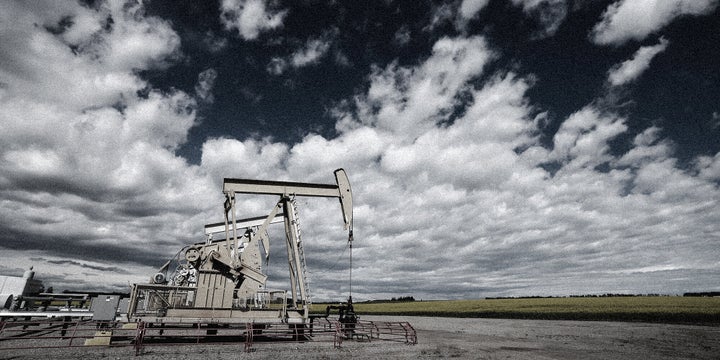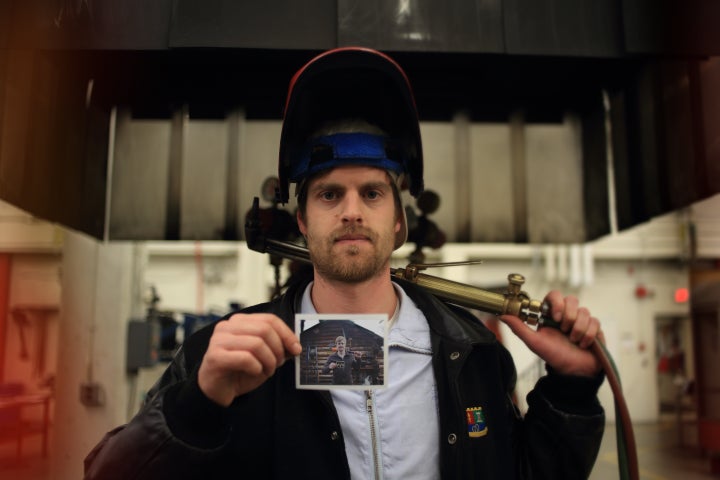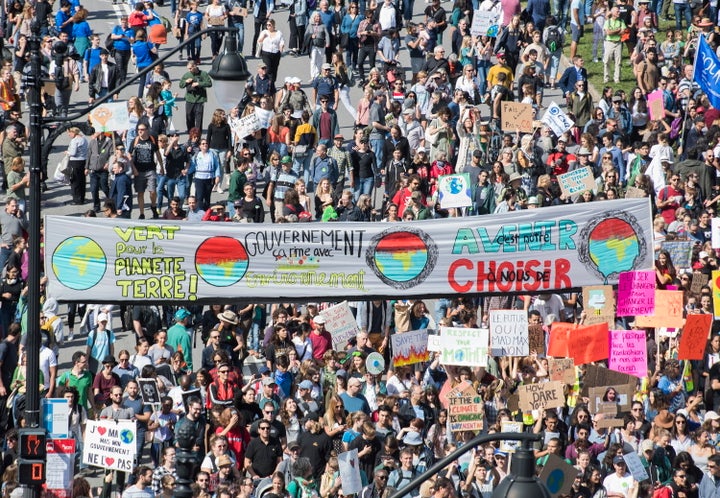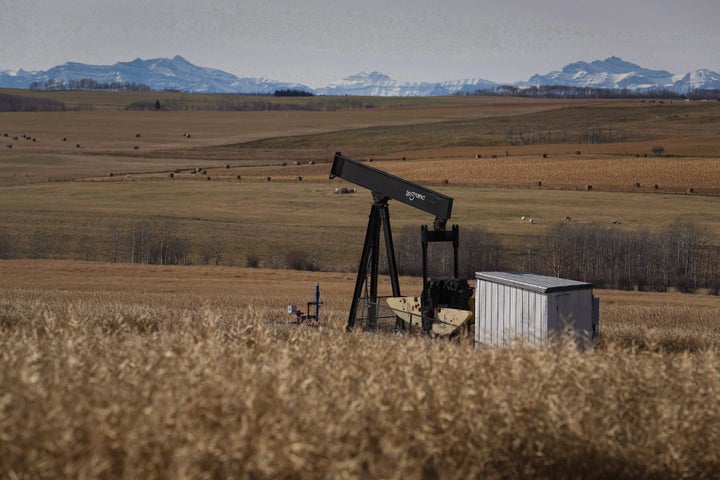
This story is part of After The Curve, an ongoing HuffPost Canada series that makes sense of how the COVID-19 crisis could change our country in the months and years ahead, and what opportunities exist to make Canada better.
On a 10-acre farm in British Columbia, Lliam Hildebrand grew up with an insatiable curiosity for the natural world and a love for working with his hands.
The latter drove him to become a welder and steel fabricator, building oil and gas infrastructure in Western Canada. On days off, he headed out on northern Alberta adventures — paddling down the Athabasca River and going on fishing trips.
He said that while he was proud to work in the fossil fuel industry, he could not ignore a growing concern that he was contributing to climate change.
“I realized pretty quickly that my trade skills could either go towards building infrastructure that is creating climate change, or reversing and preventing climate change,” Hildebrand, 35, told HuffPost Canada.
However, jobs in the renewable energy sector, such as wind, solar or biofuel, weren’t common in the early 2010s. That’s why, as oil prices plummeted in the spring of 2015, Hildebrand launched Iron & Earth, an organization to help workers transfer their skills to renewable energy projects and garner industry and government support.

Five years later, the oil and gas industry faced another crisis, as prices and demand for fossil fuels crashed amid the novel coronavirus pandemic. This spring, hundreds of oilsands workers were laid off, thousands of planned jobs were put on hold and Canada’s economy entered a recession.
This moment of vulnerability and uncertainty has cemented a groundswell of support among workers to diversify the western economy, said Hildebrand. The federal government has an “incredible” opportunity to fast-track the transition to green energy and hit its target of net-zero emissions by 2050, he said.
What’s needed is federal leadership.
“How we approach this transformation and this upgrade will really come to define the coming decade and how successful Canada is at meeting its climate targets,” said Hildebrand.
Watch: 5,000-year-old Arctic ice caps have disappeared. Story continues below.
Prime Minister Justin Trudeau’s Liberal government insists it is up for the challenge and is developing initiatives that will propel Canada not only to meet, but exceed its 2030 target of reducing green greenhouse gas emissions by 30 per cent below 2005 levels and to reach net-zero emissions by 2050.
“We can choose to embrace bold new solutions to the challenges we face and refuse to be held back by old ways of thinking,” Trudeau said last week as he announced Chrystia Freeland was replacing Bill Morneau as finance minister.
This summer, Morneau and Trudeau had reportedly butted heads over coronavirus spending, and how much should be dedicated to green initiatives, according to Reuters.
“As much as the pandemic is an unexpected challenge, it is also an unprecedented opportunity,” Trudeau continued. “This is our chance to build a more resilient Canada.”
In an interview earlier this month, Environment Minister Jonathan Wilkinson told HuffPost that his department is working on initiatives to harness stimulus spending and bring Canada closer to its targets. He declined to provide specifics, but indicated he’d target the largest sources of greenhouse gas emissions — the transportation and energy sectors, as well as inefficient buildings.

“We will need to find ways to accelerate the deployment of zero emissions vehicles. We’re going to need to significantly reduce the emissions intensity in the oil and gas sites. We’re going to need to phase out coal and move towards green energy. People need to retrofit their homes and commercial enterprises to have greater energy efficiency,” Wilkinson said.
“We’re going to have to accelerate some of the investments that need to be made in order to get there.”
2020 was supposed to be a pivotal moment for climate change action, not just for Canada, but for the world.
Unprecedented public outrage had boiled throughout 2018 and 2019, two of the hottest years on record. Millions of protesters around the world, inspired by Swedish activist Greta Thunberg, took to the streets to demand substantial action from governments to reduce emissions.
As disastrous Australian wildfires in December and January created a sense of urgency within the climate action movement, corporations signed on. It was just over six months ago that Amazon CEO Jeff Bezos pledged $10 billion to fight climate change and Microsoft announced it would be carbon negative by 2030.
Of course, we all know what actually happened.
Climate change took a backseat to the pandemic, which has dominated the public’s imagination and government agendas for months. As the House of Commons shut down in late March, in response to the first surge of COVID-19 cases, officials postponed tabling the 2020 budget that was going to be centered around climate change.
Other significant milestones were also pushed back. The annual UN Climate Change Conference (COP 26), marking five years since the Paris Agreement, was delayed, giving countries at least another year before they will have to commit to new, more ambitious plans for how they will curb global warming.
Canada’s plan for reaching its 2030 target has been delayed by months, along with appointing an expert panel to advise how to reach net-zero emissions by 2050, however both will be a top priority in the coming months, said Wilkinson.
“This will be one of the first orders of business and certainly for Canada our highest priority in terms of new legislation when the house comes back in the fall,” he said, adding that because of the pandemic, there’s now greater motivation within the government to tackle climate change.
“COVID-19 is a global crisis that came on quite quickly, but we know climate change is a global crisis in the making that is going to have more devastating impacts.
“It has given us even more impetus to say we must move forward. It will require investments to address reducing emissions and enabling productivity and competitiveness in the Canadian economy going forward.”

But any delay at the beginning of the most pivotal decade for climate change action concerns Julia Levin, Environmental Defence’s climate and energy program manager — especially given Canada’s shoddy record when it comes to honouring climate change commitments.
The Intergovernmental Panel on Climate Change’s report in 2018 said the world had 12 years to make deep cuts to emissions to avoid devastating global warming beyond 1.5 C above pre-industrial levels.
“If we lose sight of what we actually need to do in 2030, it’s going to make it very dangerous for us,” said Levin. “We’ve already waited so long, we can’t continue to wait.”
What the federal government has done so far this pandemic to stimulate the economy has been a mixed bag, Levin said.
In April, the feds announced a $1.7 billion rescue package for the oil and gas sector, although the Canadian Press reported fossil fuel companies have benefitted from closer to $16 billion in aid. That amount was still less than the $30 billion the industry said it required to stay afloat.
“It really signalled a kind of turning point because the government hadn’t appeared to cave to industry demands,” Levin said.

A large chunk of the federal funding will go to cleaning up the tens of thousands of inactive and orphan oil wells across Alberta, Saskatchewan and B.C., left by developers that can’t be located or do not have the money to reclaim the land.
Levin said that many of these companies are profitable, and should take responsibility to clean up their own mess, but providing money to improve the environment is preferable to giving handouts to the industry with no strings attached. Also, this initiative, plus $750 million dedicated to an oil industry loan program to reduce methane emissions, will generate about 10,000 jobs.
The response to the well clean up program has been substantial. As of July 31, the province reported it had received more than 36,000 applications, and had so far accepted 5,000.
“You can’t blame people for not getting on board with a program that isn’t developed yet.”
- Lliam Hildebrand, Iron & Earth
Hildebrand, the executive director of Iron & Earth, said his team is racing to get ahead of these site reclamations to save power lines and road infrastructure that would otherwise be torn down. He sees an opportunity to use them for other types of green energy projects.
What he’s looking for in a future government stimulus package is more support for industries to pivot to green energy, rather than starting from scratch, and for workers to have more access to training.
Once there are jobs, the workers will come.
“You can’t blame people for not getting on board with a program that isn’t developed yet,” Hildebrand said. “And that’s why we really need leadership from the federal level, to articulate the pathway forward.”